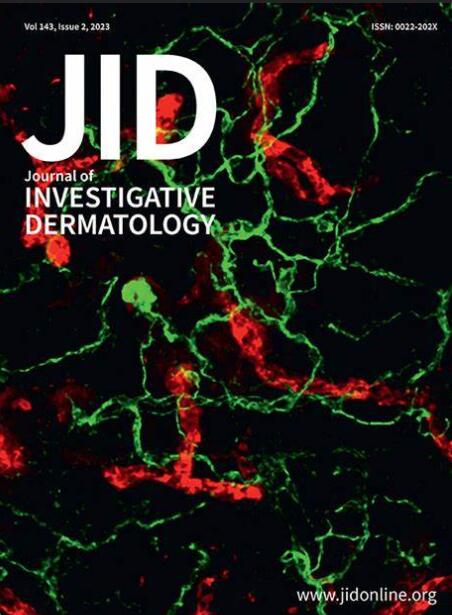DNA Damage Stress Control Is a Truncated Large T Antigen and Euchromatic Histone Lysine Methyltransferase 2–Dependent Central Feature of Merkel Cell Carcinoma
IF 5.7
2区 医学
Q1 DERMATOLOGY
引用次数: 0
Abstract
Merkel cell carcinoma (MCC) is an aggressive skin cancer with a high mortality rate. Merkel cell polyomavirus causes 80% of MCCs, encoding the viral oncogenes small T and truncated large T (tLT) antigens. These proteins impair the RB1-dependent G1/S checkpoint blockade and subvert the host cell epigenome to promote cancer. Whole-proteome analysis and proximal interactomics identified a tLT-dependent deregulation of DNA damage response (DDR). Our investigation revealed, to our knowledge, a previously unreported interaction between tLT and the histone methyltransferase EHMT2. T antigen knockdown reduced DDR protein levels and increased the levels of the DNA damage marker γH2Ax. EHMT2 normally promotes H3K9 methylation and DDR signaling. Given that inhibition of EHMT2 did not significantly change the MCC cell proteome, tLT–EHMT2 interaction could affect the DDR. With tLT, we report that EHMT2 gained DNA damage repair proximal interactors. EHMT2 inhibition rescued proliferation in MCC cells depleted for their T antigens, suggesting impaired DDR and/or lack of checkpoint efficiency. Combined tLT and EHMT2 inhibition led to altered DDR, evidenced by multiple signaling alterations. In this study, we show that tLT hijacks multiple components of the DNA damage machinery to enhance tolerance to DNA damage in MCC cells, which could explain the genetic stability of these cancers.
DNA 损伤应激控制是梅克尔细胞癌依赖 tLT 和 EHMT2 的核心特征。
梅克尔细胞癌(MCC)是一种侵袭性皮肤癌,死亡率很高。80%的梅克尔细胞癌是由MC多瘤病毒(MCPyV)引起的,该病毒编码小T抗原(sT)和截短大T抗原(tLT)。这些蛋白会损害依赖 Rb1 的 G1/S 检查点阻断,并颠覆宿主细胞的表观基因组,从而促进癌症的发生。全蛋白质组分析和近端相互作用组学发现了依赖于tLT的DNA损伤应答(DDR)失调。我们的研究发现,据我们所知,tLT 与组蛋白甲基转移酶 EHMT2 之间存在一种以前未报道过的相互作用。T抗原敲除降低了DDR蛋白水平,增加了DNA损伤标记物γH2Ax的水平。EHMT2 通常会促进 H3K9 甲基化和 DDR 信号转导。鉴于抑制 EHMT2 并未显著改变 MCC 细胞的蛋白质组,tLT-EHMT2 的相互作用可能会影响 DDR。通过 tLT,我们发现 EHMT2 获得了 DNA 损伤修复近端相互作用因子。抑制 EHMT2 可挽救去除了 T 抗原的 MCC 细胞的增殖,这表明 DDR 受阻和/或缺乏检查点效率。联合抑制 tLT 和 EHMT2 会导致 DDR 改变,多种信号改变就是证明。在这里,我们证明了tLT劫持了DNA损伤机制的多种成分,从而增强了MCC细胞对DNA损伤的耐受性,这可以解释这些癌症的遗传稳定性。
本文章由计算机程序翻译,如有差异,请以英文原文为准。
求助全文
约1分钟内获得全文
求助全文
来源期刊
CiteScore
8.70
自引率
4.60%
发文量
1610
审稿时长
2 months
期刊介绍:
Journal of Investigative Dermatology (JID) publishes reports describing original research on all aspects of cutaneous biology and skin disease. Topics include biochemistry, biophysics, carcinogenesis, cell regulation, clinical research, development, embryology, epidemiology and other population-based research, extracellular matrix, genetics, immunology, melanocyte biology, microbiology, molecular and cell biology, pathology, percutaneous absorption, pharmacology, photobiology, physiology, skin structure, and wound healing

 求助内容:
求助内容: 应助结果提醒方式:
应助结果提醒方式:


